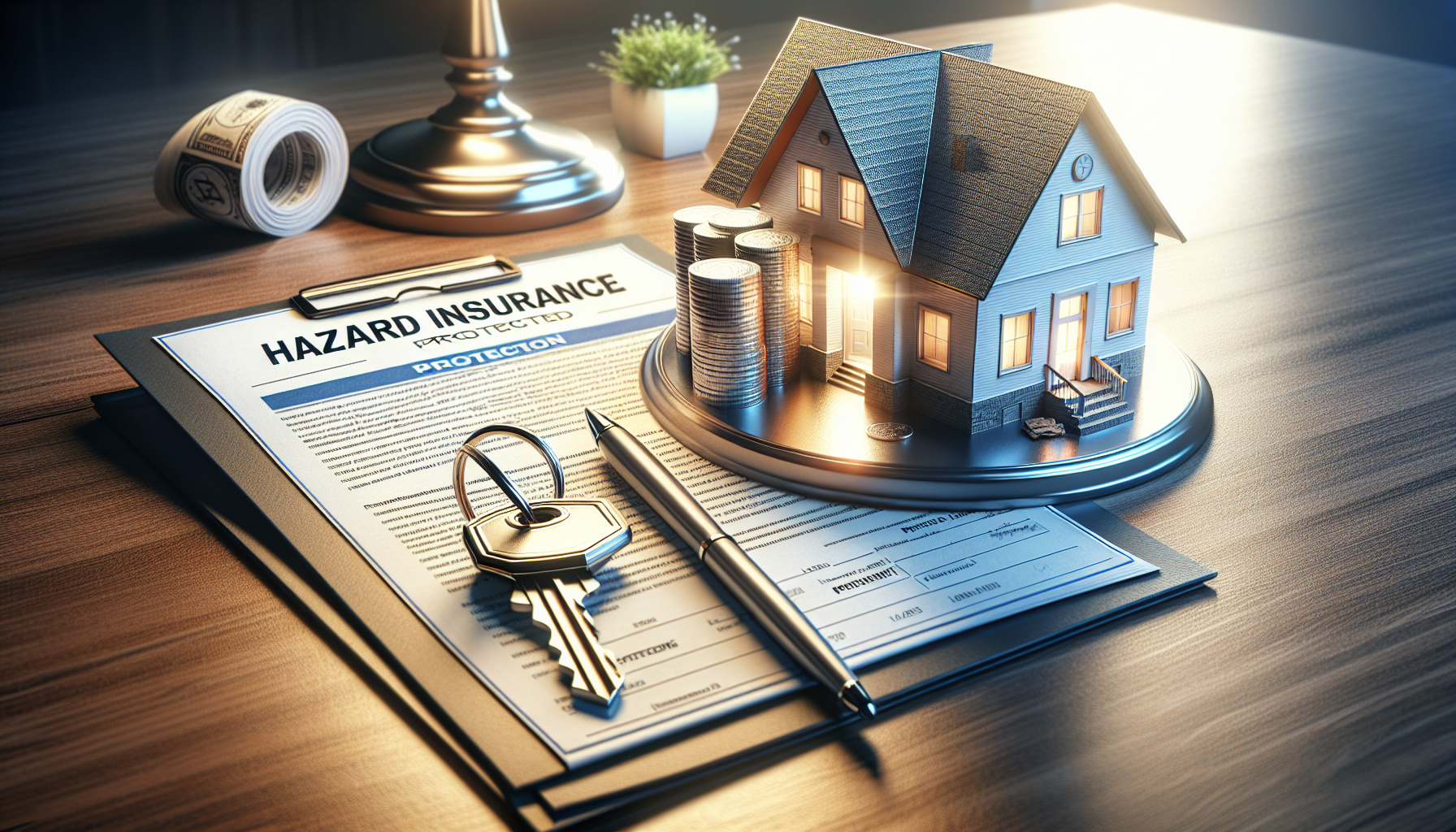
What is Hazard Insurance on a Mortgage: Everything You Need to Know
Hazard insurance is a critical component of a homeowners insurance policy, providing essential protection for the physical structure of your home against various perils. As a homeowner with a mortgage, understanding what hazard insurance covers and how it works is crucial to ensure that your investment is adequately protected.
What is Hazard Insurance and What Does it Cover?
Hazard insurance is a specific type of coverage included in a standard homeowners insurance policy. Its primary purpose is to protect the structure of your home from damages caused by covered perils, such as fire, theft, vandalism, and certain weather-related events. Understanding the scope of hazard insurance is essential for homeowners to ensure they have the necessary coverage for their property.
Hazard Insurance as Part of Homeowners Insurance
While hazard insurance is a standalone term, it is typically included as part of a broader homeowners insurance policy. In fact, when lenders require homeowners to have hazard insurance, they are referring to the dwelling coverage portion of the homeowners policy. This coverage specifically protects the physical structure of your home, which is the lender’s primary interest.
It’s important to note that hazard insurance is not synonymous with homeowners insurance. A comprehensive homeowners policy includes additional coverages, such as personal property protection and liability coverage, which are separate from the hazard insurance component. However, for many homeowners, the terms “hazard insurance” and “homeowners insurance” are often used interchangeably when discussing the required coverage for a mortgaged property.
Perils Typically Covered by Hazard Insurance
Hazard insurance policies typically cover a range of perils that can cause damage to your home’s structure. Some of the most common perils included in hazard insurance coverage are:
- Fire and smoke damage
- Lightning strikes
- Windstorms and hail
- Explosions
- Vandalism and malicious mischief
- Theft and burglary
- Damage from vehicles or aircraft
- Falling objects
- Weight of ice, snow, or sleet
- Freezing of plumbing, heating, or air conditioning systems
It’s crucial to review your specific policy to understand which perils are covered, as coverage can vary between insurers and policies. Some perils, such as floods and earthquakes, are typically excluded from standard hazard insurance and require separate coverage.
Structures Protected by Hazard Insurance
Hazard insurance primarily covers the main dwelling of your property, but it may also extend to other structures on your property, such as:
- Detached garages
- Sheds
- Fences
- Guest houses or in-law units
- Outdoor kitchens or patios
The extent of coverage for these additional structures can vary, so it’s essential to discuss your specific needs with your insurance provider to ensure you have adequate protection for all the structures on your property.
What Hazard Insurance Doesn’t Cover
While hazard insurance provides vital protection for your home’s structure, it’s important to understand its limitations. Hazard insurance does not cover every type of damage or loss that may occur on your property. Familiarizing yourself with common exclusions can help you identify areas where you may need additional coverage.
Personal Property and Liability Exclusions
One of the primary exclusions from hazard insurance is personal property. Your personal belongings, such as furniture, clothing, electronics, and other possessions, are not covered under the hazard insurance portion of your homeowners policy. To protect these items, you’ll need to have adequate personal property coverage, which is a separate component of your homeowners insurance.
Additionally, hazard insurance does not provide liability protection. If someone is injured on your property or if you face a lawsuit related to your property, you’ll need to rely on the liability coverage portion of your homeowners insurance, not your hazard insurance.
Natural Disasters Requiring Additional Coverage
While hazard insurance covers many weather-related perils, it typically excludes damage from certain natural disasters. Two of the most common exclusions are floods and earthquakes. If you live in an area prone to these events, you’ll likely need to purchase separate flood insurance or earthquake insurance to protect your home.
Flood insurance is available through the National Flood Insurance Program (NFIP) or private insurers, while earthquake insurance can be purchased as an endorsement or a separate policy. Your insurance agent can help you determine if you need these additional coverages based on your location and risk factors.
Hazard Insurance Requirements for Mortgages
When you obtain a mortgage to purchase a home, your lender will almost always require you to have hazard insurance. This requirement is put in place to protect the lender’s financial interest in your property. If your home is damaged or destroyed by a covered peril, the lender wants to ensure that their investment is protected, and the home can be repaired or rebuilt.
Why Lenders Require Hazard Insurance
Lenders view hazard insurance as a way to mitigate their risk. If a home is damaged and the homeowner cannot afford to repair it, the lender’s investment is at risk. By requiring hazard insurance, the lender ensures that there are funds available to repair or rebuild the home in the event of a covered loss.
In most cases, hazard insurance is a non-negotiable requirement for obtaining a mortgage. If you fail to maintain adequate hazard insurance coverage, your lender may purchase insurance on your behalf and add the cost to your mortgage payments. This is known as force-placed insurance and is typically more expensive and less comprehensive than a policy you would purchase yourself.
Proving Hazard Insurance Coverage to Your Lender
When you close on your mortgage, you’ll need to provide proof of hazard insurance to your lender. This is typically done by providing a copy of your insurance declarations page, which outlines your coverage limits, deductibles, and policy term.
Your lender may also require that you pay your hazard insurance premiums through an escrow account. With an escrow account, your lender will collect a portion of your annual insurance premium each month along with your mortgage payment. The lender will then pay your insurance premiums on your behalf when they come due, ensuring that your coverage remains in force.
Hazard Insurance Coverage Limits and Deductibles
When purchasing hazard insurance, two key factors to consider are your coverage limits and deductibles. These factors will impact both the amount of protection you have and the cost of your insurance premiums.
Choosing the Right Coverage Limit
Your hazard insurance coverage limit should be high enough to cover the full cost of rebuilding your home in the event of a total loss. This amount may be different from the market value of your home or the amount you paid for it, as it takes into account the current cost of labor and materials needed to reconstruct your home.
Many insurance companies offer extended replacement cost coverage, which provides an additional buffer above your dwelling coverage limit, typically 25-50%, to account for unexpected increases in construction costs. Some insurers also offer guaranteed replacement cost coverage, which pays to rebuild your home regardless of the cost, even if it exceeds your coverage limit.
Understanding Hazard Insurance Deductibles
Your hazard insurance deductible is the amount you’ll pay out-of-pocket before your insurance coverage kicks in when you file a claim. Deductibles can range from a few hundred to several thousand dollars, depending on your policy and preferences.
Choosing a higher deductible can lower your insurance premiums, as you’re taking on more financial responsibility in the event of a claim. However, it’s essential to choose a deductible that you can comfortably afford to pay if you need to file a claim.
Buying Hazard Insurance for Your Home
When shopping for hazard insurance, it’s important to compare quotes from multiple insurers to find the best coverage at a competitive price. You can work with an insurance agent or broker or obtain quotes directly from insurance companies.
Factors Affecting Hazard Insurance Premiums
Several factors can impact the cost of your hazard insurance premiums, including:
| Factor | Impact on Premiums |
|---|---|
| Home value and size | Higher value and larger homes generally have higher premiums |
| Location | Homes in high-risk areas (e.g., prone to natural disasters) may have higher premiums |
| Construction type | Homes with fire-resistant materials or newer electrical and plumbing systems may have lower premiums |
| Deductible | Higher deductibles generally result in lower premiums |
| Credit score | Better credit scores may qualify for lower premiums in some states |
When comparing quotes, make sure you’re comparing policies with similar coverage limits and deductibles to ensure an accurate comparison.
Bundling Hazard Insurance with Other Policies
Many insurance companies offer discounts for bundling your hazard insurance with other policies, such as auto or umbrella insurance. Bundling can provide significant savings on your overall insurance costs and the convenience of having multiple policies with one insurer.
When considering bundling, compare the bundled price with the cost of purchasing policies separately to ensure you’re getting the best value. Also, make sure the insurer you choose has a good reputation for customer service and financial stability.
See also:
- What Is A Mortgage Clause: Everything You Need To Know
- How to Cash Insurance Check Without Mortgage Company – Tips and Tricks
- What Happens to a Mortgage When Someone Dies Without a Will
- When Is Your First Mortgage Payment Due?
- How Mortgage Brokers Rip You Off: 5 Worst Ways Exposed
